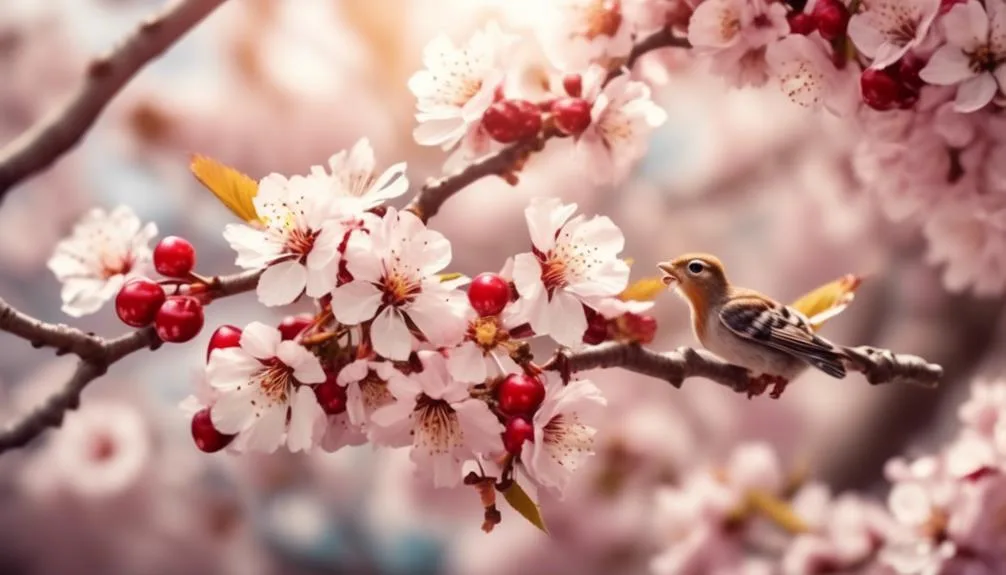You've planted a cherry tree in your garden, looking forward to its sweet fruits. But have you thought about its impact on wildlife?
Cherry trees do more than just beautify your yard; they're crucial for supporting wildlife. They provide shelter and nesting spots for birds and offer nectar for pollinators. Their role in the ecosystem is far-reaching.
How exactly do cherry trees benefit wildlife? Let's take a closer look at their fascinating relationship with the natural world.
Cherry Trees as Habitat for Wildlife
Cherry trees provide essential habitat for a diverse array of wildlife. They offer food, shelter, and nesting sites for various species. The branches of cherry trees provide safe havens for birds to build their nests, protecting their eggs and young from predators. The dense foliage also offers shelter for small mammals, providing a secure place to hide from larger predators and harsh weather.
In addition to nesting and shelter, the cherry trees' blossoms and fruit serve as a vital food source for many animals. The flowers attract pollinators, while the fruit provides nourishment for a variety of wildlife. Birds, insects, and small mammals all depend on the blossoms and fruit of cherry trees for sustenance.
Wildlife Benefiting From Cherry Trees
A bustling ecosystem thrives amidst the branches and blossoms of cherry trees, with a diverse array of wildlife benefiting from the abundant resources they provide. Here's how cherry trees support wildlife:
- Bird Nesting
Cherry trees offer ideal nesting sites for various bird species. The dense foliage provides shelter and protection, while the sturdy branches provide secure platforms for building nests. This creates a safe environment for birds to raise their young, contributing to the overall biodiversity of the area.
- Tree Hollows
As cherry trees age, they develop natural hollows in their trunks, which serve as crucial habitats for a variety of wildlife. These hollows provide shelter for small mammals, birds, and insects, offering protection from predators and harsh weather conditions.
Cherry trees thus play a vital role in supporting and sustaining a thriving wildlife community.
Impact of Cherry Trees on Biodiversity
Amidst the blossoming branches of cherry trees, a rich tapestry of biodiversity unfolds, shaping and enriching the surrounding ecosystem.
Cherry trees contribute to soil health by fostering an environment that supports a diverse range of microorganisms, contributing to nutrient cycling and soil stability. The fallen cherry blossoms provide organic matter, enriching the soil and supporting a healthy microbial community.
However, the impact of cherry trees on biodiversity can be complex, as they can also promote the growth of invasive species that compete with native plants for resources. This can potentially disrupt the balance of the ecosystem and affect the diversity of plant species.
Careful management and monitoring are essential to ensure that cherry trees positively impact biodiversity without inadvertently promoting invasive species.
Cherry Trees and Pollinators
Nurturing a diverse range of microorganisms in the soil, cherry trees play a crucial role in supporting pollinators and their vital contribution to the ecosystem.
- Pollinator Attraction
Cherry trees attract a variety of pollinators such as bees, butterflies, and birds, enhancing the overall biodiversity of the area. Their blooms provide a vital early food source for emerging pollinators, ensuring a healthy start to their life cycle.
- Ecosystem Support
The cherry blossom, with its abundant nectar, serves as a crucial food source for pollinators, aiding in their survival and promoting their activity in the ecosystem. By facilitating pollination, cherry trees contribute to the production of fruits and seeds, which in turn sustains a myriad of wildlife species.
Cherry trees thus not only enhance the beauty of the landscape, but also play a pivotal role in supporting and sustaining diverse pollinator populations.
Cherry Trees and Food for Wildlife
Cherry trees provide a rich and essential food source for a diverse array of wildlife, sustaining the delicate balance of the ecosystem.
The fruits of cherry trees are a vital food source for birds, including robins, thrushes, and waxwings, which rely on the energy-rich fruit during their migratory journeys.
Additionally, small mammals like squirrels and chipmunks feast on the fallen cherries, helping to disperse the tree's seeds and contributing to the regeneration of cherry tree populations.
Insects, such as bees and butterflies, also benefit from cherry trees, as they rely on the nectar and pollen from the blossoms for sustenance.
Conclusion
In sum, cherry trees serve as vital havens and food sources for a diverse array of wildlife, bolstering biodiversity and ecosystem vitality.
By planting cherry trees, not only can you enrich the landscape, but you can also actively contribute to supporting local wildlife.
Consider the impact of these trees on your surroundings and the enduring benefits they offer to the wildlife community.

My interest in trees started when I first saw the giant sequoias in Yosemite.
I was a teenager then, and I remember thinking, “I need to learn more about this.”
That moment stuck with me.
A few years later, I went on to study forestry at Michigan Tech.
Since graduating, I’ve worked in a mix of hands-on tree care and community education.
I’ve spent over ten years helping people understand how to plant, maintain, and protect the trees in their neighborhoods.
I don’t see trees as just part of the landscape.
They are living things that make a real difference in our daily lives.
